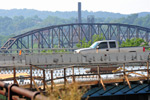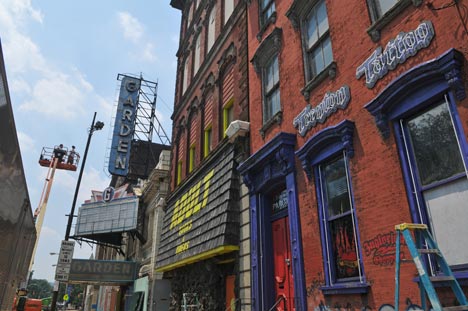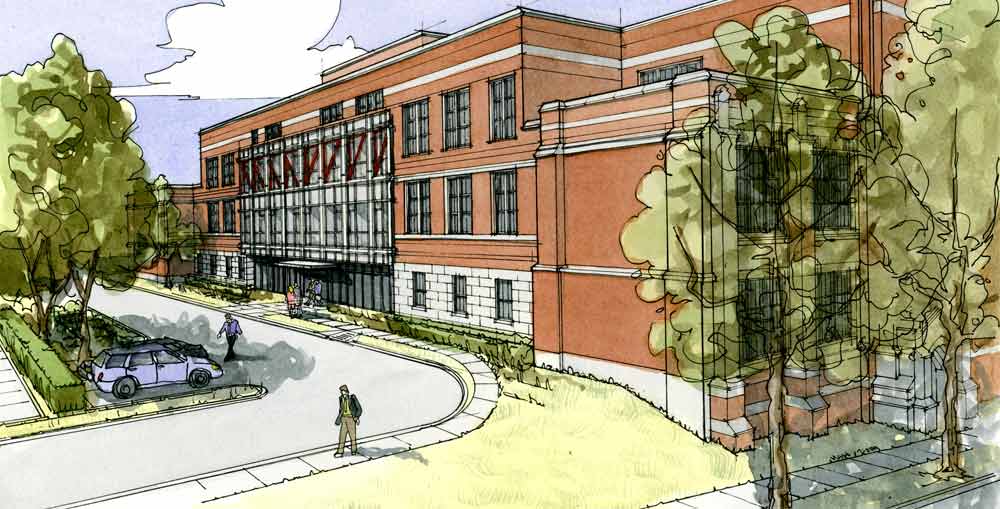
Category Archive: Pittsburgh Tribune Review
-
Charleroi’s Historic Goaziou Shop to Reopen With Tours, Open House
By Ron Paglia
FOR THE PITTSBURGH TRIBUNE-REVIEW
Sunday, July 18, 2010One of the community’s oldest and most historic buildings will be the focus of attention Monday when the official reopening of The Goaziou Shop is celebrated beginning at noon.
The open house, presented by the Charleroi Area Historical Society, will run until 3:30 p.m. at the site at 807 Fallowfield Ave. and is open to the public. Light refreshments will be served, and tours of the building will be available.
The Goaziou Shop, in Charleroi’s historic district, was the commercial print shop and residence of the late Franco-American Louis Goaziou, a union socialist and main advocate for the North American Co-Masonry movement, for which the first charter was established in Charleroi.
The building, which opened at the turn of the last century, also housed a printing shop owned and operated for many years by Herb Goaziou.
The building’s accommodations for disabled visitors are made available through a grant from the Washington County Tourism and Promotion Agency.
Regular visiting hours at The Goaziou Shop are from 11:30 a.m. to 3:30 p.m. Monday and Friday.
Additional information is available at the historical society’s administration office and the Genealogy and History Research Center at 608 Fallowfield Ave., 724-483-2030, or The Goaziou Shop, 724-483-4961.
-
Nonprofits Urge Estate Tax at ’09 Levels
By Bill Zlatos
PITTSBURGH TRIBUNE-REVIEW
Tuesday, July 20, 2010The head of the nation’s largest umbrella group for nonprofits urged reinstatement of the estate tax to 2009 levels to encourage charitable giving.
“Permanent repeal of the estate tax could result in the loss of $1 trillion in tax revenue over 10 years,” said Diana Aviv, president and CEO of Independent Sector, a Washington-based organization composed of nonprofit groups, foundations and corporate-giving programs.
Aviv spoke Monday to about 100 leaders of the region’s nonprofit community at a seminar sponsored by Grantmakers of Western Pennsylvania in the August Wilson Center for African American Culture, Downtown.
The estate tax expired at the end of 2009 and is scheduled to return Jan. 1, with a $1 million exemption and the balance of the estate taxed at 55 percent.
Some senators, however, are trying to reinstate the estate tax sooner under terms that Independent Sector believes could hurt charities.
Aviv favors the reinstatement of the 2009 terms, which are supported by the House and President Obama. Last year, the first $3.5 million of an individual’s estate, or $7 million for a couple, was exempt, and the balance was taxed at 45 percent.
Aviv urged support of the Nonprofit Sector and Community Solutions Act of 2010, proposed by Rep. Betty McCollum, a Democrat from Minnesota.
The bill would create a 16-member council to strengthen the links among Congress, the White House and the nonprofit community. It would create an interagency working group consisting of cabinet members and directors of relevant agencies, and would require the federal government to collect data on nonprofits.
“I don’t think anybody thinks it will be passed this year,” Aviv said. “The hope is that the next two or three years will build enough support to get it passed.”
Aviv contends that nonprofits deserve a seat at the table in Washington. Some 13 million people work full time for nonprofits, or 10 percent of America’s work force.
“I like the idea that the federal government, in addition to mandating regulations, might help the nonprofit sector do what it does better,” said Gregg Behr, executive director of The Grable Foundation, a Downtown philanthropy.
-
Old School Steps to Front of the Class
By Eric Heyl
PITTSBURGH TRIBUNE-REVIEW
Wednesday, July 21, 2010Consider it a textbook example of how to transform a dilapidated eyesore into a potential community jewel.
For nearly a quarter-century, the former South Hills High School in Mt. Washington slowly deteriorated while various redevelopment proposals were about as successful as the initial Hindenburg launch.
As recently as 18 months ago, the enormous 155,000-square foot building occupying an entire city block at the corner of Ruth and Eureka streets stood empty and decaying.
Surrounded by an imposing chain link fence, the old school appeared as though it never would be anything more than a refuge for birds seeking shelter through the holes in the roof.
Since then, the scene has changed dramatically.
“We’ve come a long way,” Victor Rodriguez said Tuesday, standing in the vicinity of where the principal’s office used to be. “I think this is pretty monumental in terms of what we’ve accomplished.”
Rodriguez is senior vice president of a.m. Rodriguez Associates, which purchased the building from the city’s Urban Redevelopment Authority two years ago for $1. Given the structure’s condition at the time, Rodriguez might have overpaid for it.
But following a $23 million makeover that included $10 million in public money, the structure will reopen in about six weeks as the South Hills Retirement Residence.
The place is proving popular among the senior crowd even before the first tenants move in. As contractors scurry to apply the finishing touches, 42 of the building’s 106 units have been leased.
Rodriguez yesterday provided me a tour of the building, the inside of which looks virtually nothing like it did when the Class of ’86 closed the school for good.
Although some of the original hardwood and ornate metal railings were incorporated into the interior design, it’s unlikely the 2,200 members of the school’s alumni association would recognize the place.
That’s a good thing.
Rodriguez removed several unsalvageable portions of the former school, including the auditorium and the swimming pool, while adding amenities the 94-year-old building desperately needed — elevators and air conditioning.
In addition, a portion of the building is expected to house medical offices, which should further increase foot traffic in what had become a desolate neighborhood. An early childhood development center also might occupy some space.
“What we’re striving for here is something community-changing,” Rodriguez said.
Joshua “J.T.” Smith, board president of the Mt. Washington Community Development Corp., lives about two blocks away and is thrilled with how the place looks.
“For years, that building created a real negative mood with all of that prison-style fencing around it,” he said. “It’s great to walk by now and see something vibrant and alive, with the new trees and the clean sidewalks. This is going to alter the mentality of the whole neighborhood.”
Again, it’s a textbook example of transformation.
For an old school, what could be more appropriate?
-
Artists on Board for Mural Project Behind Tarentum Station Restaurant
By Tom Yerace
VALLEY NEWS DISPATCH
Tuesday, July 20, 2010
Last updated: 7:41 amThe mural project for the wall behind the Tarentum Station restaurant is picking up steam, according to borough officials.
Borough Manager Bill Rossey said he has been contacted by five local artists who want to volunteer their services for the project.
Councilman Ray Kerr, who is coordinating the project with Rossey, said more artists are needed on a volunteer basis since the borough wasn’t able to secure a grant to pay for the project.
He said paint for the mural is being donated by two borough paint stores: Van Sciver’s Wall Covering and Paint and Verner’s Paint Center.
“Right now we are moving pretty good on it,” Kerr said.
Rossey said a primer was applied to the wall over the weekend.
It’s ready for the mural, which will be 175 feet long and range from 6 feet to 4 feet high.
Kerr and Rossey said the mural will have a historical theme, using the image of a train, but with the cars of the train depicting historical people and events related to the borough.
“What we need now are people (subjects) from Tarentum,” Kerr said. “We need faces if anybody can come up with some pictures, they would be welcomed.”
Kerr said the project should be completed before the end of summer.
“It will certainly be a point of interest for people coming through town to pass by and look at that wall, ” Rossey said.
In other business:
• Council approved applying for a federal Community Development Block Grant for Streetscape improvements to the business district.
The application will be for $105,000 to do the actual improvements, such as new sidewalks and lighting, according to Rossey. He said that will supplement a $60,000 grant the borough received this year to pay for planning of the improvements.
Rossey said the borough will be putting out a request for proposals on designs soon.
In addition to the $60,000, the borough also has set aside $15,000 from its budget for planning costs, Rossey said.
He also said that it also is reserving $45,000 to use for the improvements and could use money left over from the $75,000 reserved for planning to pay for the actual work.
He said borough officials believe they can do at least one block of E. Sixth Avenue and try to do subsequent blocks every year.
• Council has granted permission for the Alle-Kiski Historical Society to hold a Civil War encampment in Riverview Park. The encampment by re-enactors will be Aug. 21 and 22.
-
Firms Pitch Building Plans for Garden Theater Area
By Bill Vidonic
PITTSBURGH TRIBUNE-REVIEW
Tuesday, July 20, 2010The owner of a central North Side business only wanted to hear one issue addressed Monday about the redevelopment of the block surrounding the vacant Garden Theater.
“Parking, parking, parking,” said Irene Karavolos, co-owner of Steve’s New York Hot Dogs on Federal Street. “You can’t bring in more businesses when little businesses already are starving for parking.”
More than 200 people crowded into an auditorium at the Children’s Museum of Pittsburgh to hear several proposals for the block surrounding the former X-rated theater, with five developers promising to spend tens of millions of dollars to revitalize the blighted section of the North Side.
All submitted proposals calling for a mix of retail and residential development; two called for the partial or complete destruction of the vacant Garden Theater auditorium.
Kirk Burkley, president of Northside Tomorrow, which is coordinating redevelopment efforts, said the Garden wouldn’t vanish entirely under any of the proposals. City and national historical designations mean the building’s facade must be preserved.
“This project affects more than just the central North Side,” Burkley said.
North Side resident Matt Long said he’d like to see the Garden restored as an independent filmhouse.
“I don’t think retail would be what I’d put there,” Long said.
Tom Hardy, a consultant with Northside Tomorrow, said a decision could come in the next couple of months.
“We have some momentum now,” Hardy said. “There’s an interest in keeping that momentum going.”
North Side visionsDevelopment proposals for the Garden Theater block:
• Barron Commercial Real Estate, Pittsburgh: Demolish the former Garden Theater auditorium, but preserve and restore the remaining historic properties into a mix of housing and retail development.
• Wells and Company, Spokane, Wash.: Restore the Garden Theater auditorium for a performing arts center; build apartments in the former Masonic building, along with a first-floor restaurant/brew pub; and restore buildings along West North Avenue and Reddour Street.
• Zukin Development Corp., Philadelphia: Create retail space, including a specialty grocery store, by demolishing part of the Garden Theater; create retail space and apartments in the Masonic Hall, the Bradberry apartment building and other properties.
• Aaron Stubna and William Porco, Coraopolis: Convert the Garden into a multi-purpose theater hosting live entertainment and films.
• Resaca LLC, Pittsburgh: Redevelop the Bradberry into 16 one-bedroom apartments.
Source: Northside Tomorrow LLC
-
$17.5 Million for Steel Heritage Sought
dBy Matthew Santoni, PITTSBURGH TRIBUNE-REVIEW
Saturday, July 17, 2010
National heritage park promoters want a ramp built at the Rankin Bridge to provide better access to the former Carrie Furnace (background). Sidney Davis | Tribune-Review
Allegheny County officials are hoping the federal government will invest $17.5 million in a project to turn a former steelmaking site into a national heritage park and build a ramp at the Rankin Bridge to lead visitors to it.
The county, city of Pittsburgh, Port Authority and Port of Pittsburgh Commission are among agencies seeking a share of $600 million in transportation grants that would fund projects to reduce congestion, promote economic activity or improve livability.
At Carrie Furnace, the county wants to build a “flyover” ramp from the interchange at the foot of the Rankin Bridge to carry traffic above four railroad tracks that isolated the former steel mill.
“The (current) access is good for emergency vehicles and some other traffic, but it’s over two sets of active railroad tracks, and you’d have to wind your way back there on a couple of little, local streets,” said Bob Hurley, deputy director of the county’s Department of Economic Development.
The county wants to redevelop 148 acres that once housed the blast furnaces along the Monongahela River in Rankin, part of the former U.S. Steel Homestead Works. The project would include homes, offices and light industry, along with a park commemorating the Mon Valley’s industrial heritage, Hurley said.
The Homestead-based Rivers of Steel National Heritage Area, which took over the furnaces, wants to offer public tours of the site to drum up support for a museum, said Sherris Moreira, director of marketing and tourism development. Built in 1907 of steel plate and brick, the Carrie Furnaces No. 6 and 7 tower 92 feet above the river as examples of pre-World War II iron-making technology. They are the only non-operative blast furnaces remaining in Pittsburgh. In the 1950s and ’60s, they produced up to 1,250 tons of iron a day.
The county tried to get stimulus money for the project and did not; that application asked for $60 million and included a plan to convert an old bridge over the Mon for cars and pedestrians going to Route 837 and The Waterfront. Officials will still try to get money for the bridge, Hurley said.
The $600 million in transportation grants will be awarded in fall. Others seeking money:
• Port of Pittsburgh Commission, as a government partner for river industries. Cecil-based Consol Energy Inc. wants $44 million to add a coal storage area to its Alicia Docks near Brownsville, and Three Rivers Marine and Rail Terminal near Charleroi wants $1.5 million to upgrade railroad connections. The companies would invest matching money.
• The Port Authority of Allegheny County might reapply for money to start its “Better Bus” or “Rapid Bus” initiative, said spokesman Jim Ritchie. The authority plans to convert nine routes to “rapid bus” service that would have fewer stops, use ticket machines at bus stops instead of fare boxes on buses and get priority at traffic signals in order to make faster trips to Pittsburgh International Airport, Downtown, Oakland, the East End and the Mon Valley.
-
Rodef Shalom’s Garden Grows into Latest Exhibit of Wearable Greens
By Alaina Raftis , TRIBUNE-REVIEW
Thursday, July 15, 2010
The heavily cultivated and well-maintained garden -- which sits on a third of an acre off of Fifth Avenue in Oakland -- was created by Irene Jacob, a botanist who founded the docent program at Phipps Conservatory and Botanical Gardens, and her husband, Rabbi Walter Jacob, to bring people closer to the Bible in a nontraditional way. Justin Merriman | Tribune-Review
The lush greenery at Rodef Shalom’s Biblical Botanical Garden is celebrating it’s 25th year with a new exhibit titled “What Shall I Wear?”
This year, the garden showcases various plants and flowers that have been used to make clothing and fragrances for thousands of years.
The heavily cultivated and well-maintained garden — which sits on a third of an acre off of Fifth Avenue in Oakland — was created by Irene Jacob, a botanist who founded the docent program at Phipps Conservatory and Botanical Gardens, and her husband, Rabbi Walter Jacob, to bring people closer to the Bible in a nontraditional way.
Often referred to as “Little Israel” because its geography replicates the confines of the Holy Land, the garden features various miniature landmarks such as Mt. Hermon, a mound of stones stacked beneath the shade of the billowing Acacia trees, and the Jordan River, a tranquil stream of water trickling from one corner of the garden to another.
The thousands of signatures penned in the guest book each season are only one sign of the garden’s success.

Often referred to as "Little Israel" because its geography replicates the confines of the Holy Land, the garden features various miniature landmarks such as Mt. Hermon, a mound of stones stacked beneath the shade of the billowing Acacia trees, and the Jordan River, a tranquil stream of water trickling from one corner of the garden to another. Justin Merriman | Tribune-Review
“This is the largest and most complete garden of its kind,” says Arlyn Gilboa, who has been a docent at the garden for 15 years, “It’s wholly dedicated.”
The garden contains 56 out of 110 plants specifically mentioned in the Bible and an additional 50 flowers that Jacob added to awaken the verdant oasis.
“Some people come to Pittsburgh just to see the garden,” says Jean Simon, another docent.
Plants that aren’t mentioned in the Bible were given creative names such as, “Jacob’s Coat,” “Angel’s Tears” and “Elijah’s Blue” to play along with the biblical theme.
This year’s exhibit “was just something new that we haven’t focused on before,” Gilboa says. “Sometimes our exhibits don’t have biblical roots, but this year it certainly does.”

The garden contains 56 out of 110 plants specifically mentioned in the Bible plus more. Justin Merriman | Tribune-Review
Some of the plants featured in this year’s exhibit are used for the essential oils in perfumes and fragrances. They include, among others, banana shrubs, carnations, chamomile, gardenia, geranium, jasmine, kumquat, lemon verbena, mock orange, musk plant, myrtle, patchouli, rose, rosemary and sage. The cotton and flax plants also are displayed and both have been used to make clothing since the ancient times.
“It’s a wonderful thing,” Gilboa looks at the two massive Cedar of Lebanon trees at the entrance to the garden. “The fact is that the ancients were dependent on plants, and so are we. For me, I feel a strong connection with Jewish history when I’m here. It’s such a treat.”
Rodef Shalom Biblical Botanical GardenWhen: Through Sept. 15. Hours: 10 a.m.-2 p.m. Sundays-Thursdays; 7-9 p.m. Wednesdays; noon-1 p.m. Saturdays Guided tours available 12:15-1 p.m. Aug. 6 and Sept. 3
Admission: Free
Where: Rodef Shalom Temple, 4905 Fifth Ave., Oakland
Details: 412-621-6566
-
North Side Theater is “Spruced Up” — for Hollywood
By Bill Vidonic
PITTSBURGH TRIBUNE-REVIEW
Friday, July 16, 2010
Workers are transforming the old Garden Theater and surrounding buildings in the North Side into a seedy city block of Trenton, N.J., in preparation for filming next week of the movie "One for the Money," starring Katherine Heigl. JC Schisler | Tribune-Review
More than one person passing the former Garden Theater in the North Side did a double-take Thursday, likely wondering whether a decade of working to rid the block of porn establishments suddenly reversed.
Workers replaced the neon on the old X-rated theater’s dilapidated sign. Next door, a painter finished the words “Adult Books and Videos” on the old Apache Bar facade, while others put finishing touches on the Trenton Tattoo parlor, complete with neon lights and spray-painted graffiti.
“(Former) Mayor Murphy took a nap, and here’s what happened,” painter Darien D’Alfonso joked.
Turns out it’s just movie magic.
A production crew for the film “One For the Money” starring Katherine Heigl is transforming the blighted city block into a seedy Trenton, N.J., street; filming starts Wednesday.
That means bringing the exterior of the Garden back to life and creating fake businesses, including a hoagie shop, from vacant storefronts.
“From our perspective, it’s quite ironic, but at the same time it’s exciting,” said Joanna Doven, spokeswoman for Pittsburgh Mayor Luke Ravenstahl. “There are good positive things happening in that area.”
The city spent millions in a lengthy legal battle to clear dilapidated buildings from the section of North Avenue near Allegheny General Hospital before it bought the Garden for $1.1 million in 2007.
“I think it’s great if it’s bringing the city some money,” neighbor Laurie Charlton said about the movie production. “Everybody in the neighborhood is excited about this block coming back to life.”
The Northside Leadership Conference is accepting redevelopment proposals for the Garden and surrounding buildings. A meeting about the redevelopment is scheduled for 6 p.m. Monday in the Children’s Museum.
“It’s a new day there soon,” Doven said.
For a little while longer, though, it will look like the old days.
“I think it’s kinda stupid,” North Side resident William McCue said. “They could have just been here three or four years ago, and everything would have been open for them.”

